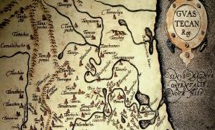Time-Span
Canonical URL http://www.cidoc-crm.org/cidoc-crm/E52_Time-Span
Durée
Período de Tempo
Time-Span
Trwanie
Zeitspanne
Χρονικό Διάστημα
Интервал Времени
时段
This class comprises abstract temporal extents, in the sense of Galilean physics, having a beginning, an end and a duration. Time Span has no other semantic connotations. Time-Spans are used to define the temporal extent of instances of E4 Period, E5 Event and any other phenomena valid for a certain time. An E52 Time-Span may be identified by one or more instances of E49 Time Appellation. Since our knowledge of history is imperfect, instances of E52 Time-Span can best be considered as approximations of the actual Time-Spans of temporal entities. The properties of E52 Time-Span are intended to allow these approximations to be expressed precisely. An extreme case of approximation, might, for example, define an E52 Time-Span having unknown beginning, end and duration. Used as a common E52 Time-Span for two events, it would nevertheless define them as being simultaneous, even if nothing else was known. Automatic processing and querying of instances of E52 Time-Span is facilitated if data can be parsed into an E61 Time Primitive.
| Property | Expected type | Definition |
|---|---|---|
| P79_beginning_is_qualified_by |
Literal
|
This property qualifies the beginning of an E52 Time-Span in some way. The nature of the qualification may be certainty, precision, source etc. |
| P80_end_is_qualified_by |
Literal
|
This property qualifies the end of an E52 Time-Span in some way. The nature of the qualification may be certainty, precision, source etc. |
| P81_ongoing_throughout |
Literal
|
This property describes the minimum period of time covered by an E52 Time-Span. Since Time-Spans may not have precisely known temporal extents, the CRM supports statements about the minimum and maximum temporal extents of Time-Spans. This property allows a Time-Span’s minimum temporal extent (i.e. its inner boundary) to be assigned an E61 Time Primitive value. Time Primitives are treated by the CRM as application or system specific date intervals, and are not further analysed. |
| P81a_end_of_the_begin |
xsd:dateTime
|
This is defined as the first boundary of the property P81 |
| P81b_begin_of_the_end |
xsd:dateTime
|
This is defined as the second boundary of the property P81 |
| P82_at_some_time_within |
Literal
|
This property describes the maximum period of time within which an E52 Time-Span falls. Since Time-Spans may not have precisely known temporal extents, the CRM supports statements about the minimum and maximum temporal extents of Time-Spans. This property allows a Time-Span’s maximum temporal extent (i.e. its outer boundary) to be assigned an E61 Time Primitive value. Time Primitives are treated by the CRM as application or system specific date intervals, and are not further analysed. |
| P82a_begin_of_the_begin |
xsd:dateTime
|
This is defined as the first boundary of the property P82 |
| P82b_end_of_the_end |
xsd:dateTime
|
This is defined as the second boundary of the property P82 |
| P160i_is_temporal_projection_of |
E92_Spacetime_Volume
|
|
| P164i_was_time-span_of |
E93_Presence
|
|
| P4i_is_time-span_of |
E2_Temporal_Entity
|
|
| P78_is_identified_by |
E49_Time_Appellation
|
This property identifies an E52 Time-Span using an E49Time Appellation. |
| P83_had_at_least_duration |
E54_Dimension
|
This property describes the minimum length of time covered by an E52 Time-Span. It allows an E52 Time-Span to be associated with an E54 Dimension representing it’s minimum duration (i.e. it’s inner boundary) independent from the actual beginning and end. |
| P84_had_at_most_duration |
E54_Dimension
|
This property describes the maximum length of time covered by an E52 Time-Span. It allows an E52 Time-Span to be associated with an E54 Dimension representing it’s maximum duration (i.e. it’s outer boundary) independent from the actual beginning and end. |
| P86_falls_within |
E52_Time-Span
|
This property describes the inclusion relationship between two instances of E52 Time-Span. This property supports the notion that a Time-Span’s temporal extent falls within the temporal extent of another Time-Span. It addresses temporal containment only, and no contextual link between the two instances of Time-Span is implied. |
| P86i_contains |
E52_Time-Span
|
|
| Property | On types | Definition |
| P160_has_temporal_projection |
E92_Spacetime_Volume
|
This property describes the temporal projection of an instance of an E92 Spacetime Volume. The property P4 has time-span is the same as P160 has temporal projection if it is used to document an instance of E4 Period or any subclass of it.
|
| P164_during |
E93_Presence
|
This property relates an instance of E93 Presence with an arbitrary instance of E52 Time-Span that
defines the section of the spacetime volume that this instance of E93 Presence is related to by the property P166 was a presence of (had presence).
|
| P4_has_time-span |
E2_Temporal_Entity
|
This property describes the temporal confinement of an instance of an E2 Temporal Entity.
The related E52 Time-Span is understood as the real Time-Span during which the phenomena were active, which make up the temporal entity instance. It does not convey any other meaning than a positioning on the “time-line” of chronology. The Time-Span in turn is approximated by a set of dates (E61 Time Primitive). A temporal entity can have in reality only one Time-Span, but there may exist alternative opinions about it, which we would express by assigning multiple Time-Spans. Related temporal entities may share a Time-Span. Time-Spans may have completely unknown dates but other descriptions by which we can infer knowledge.
|
| P78i_identifies |
E49_Time_Appellation
|
|
| P83i_was_minimum_duration_of |
E54_Dimension
|
|
| P84i_was_maximum_duration_of |
E54_Dimension
|
|
| P86_falls_within |
E52_Time-Span
|
This property describes the inclusion relationship between two instances of E52 Time-Span.
This property supports the notion that a Time-Span’s temporal extent falls within the temporal extent of another Time-Span. It addresses temporal containment only, and no contextual link between the two instances of Time-Span is implied.
|
| P86i_contains |
E52_Time-Span
|
| predicate | object |
|---|---|
| comment |
"This class comprises abstract temporal extents, in the sense of Galilean physics, having a beginning, an end and a duration.
Time Span has no other semantic connotations. Time-Spans are used to define the temporal extent of instances of E4 Period, E5 Event and any other phenomena valid for a certain time. An E52 Time-Span may be identified by one or more instances of E49 Time Appellation.
Since our knowledge of history is imperfect, instances of E52 Time-Span can best be considered as approximations of the actual Time-Spans of temporal entities. The properties of E52 Time-Span are intended to allow these approximations to be expressed precisely. An extreme case of approximation, might, for example, define an E52 Time-Span having unknown beginning, end and duration. Used as a common E52 Time-Span for two events, it would nevertheless define them as being simultaneous, even if nothing else was known.
Automatic processing and querying of instances of E52 Time-Span is facilitated if data can be parsed into an E61 Time Primitive.
"@en
|
| label |
"Durée"@fr
"Período de Tempo"@pt "Time-Span"@en "Trwanie"@pl "Zeitspanne"@de "Χρονικό Διάστημα"@el "Интервал Времени"@ru "时段"@zh |
| type |
owl:Class
|
| subClassOf |
E1_CRM_Entity
|

